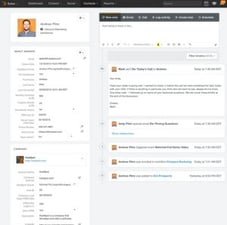
What is progressive profiling? It’s a practice modern marketers use, often with the help of marketing automation, to gather lead intel incrementally to benefit conversion rates.

How does progressive profiling work?
With marketing automation software offering dynamic or smart form fields, the marketer can progressively profile leads. With iterative forms, the marketer can designate which questions appear on a form, based on what is already known about that lead.
For example, on a first site visit someone who downloads a buyer’s tip sheet will typically be asked for name and email. Yet on another interaction with the site, the form field for company name might be replaced with job title and instead of email address the marketer might ask for a twitter handle to enable sales to learn more about the lead on social media.
A CMO's Guide to B2B Lead Generation [Free eBook PDF]![]()

Why should you use progressive profiling?
Progressive profiling can increase sales leads and promote better conversion rates. Unless they are learning more about themselves or their relationships (Cosmo quiz any one?), people are typically reluctant to complete forms. Shortening the form by asking different questions over time lets the marketing team provide the sales team with detailed contact files for qualified leads, but saves the lead from having to answer 14 questions when they’ve only just started identifying a need in the first place.
Related reading: 5 Simple Ways to Increase Sales Leads
Avoiding repetition in forms encourages people to complete the process as well. Existing leads are much more likely to redeem offers, subscribe to blogs, or download gated content if they aren’t having to provide all of the same data each time they return to the site. Progressive profiling helps remove the tedious burden of filling out long winded forms, while still having the benefit of lead capture.
Progressive profiling can also help the marketer to better identify qualified leads, helping to shorten the sales cycle. In targeting the right audience for the right questions, marketers set themselves up to ask more direct questions. For example, after the lead has visited the site several times, a form question might become: “What is your timeframe to buy?” or “What products do you use currently?”
Best way to use progressive profiling?
It may sound as if we’re endorsing a short, sweet form at the beginning, waiting to gain more insight into the lead as they continue to visit the site. This is true only in that progressive profiling embraces a succinct form.

Marketing automation software streamlines lead nurturing workflows. Progressive profiling saves the marketer time by helping identify leads in varying stages of the buyer’s journey. Still, you want to ask for the most important information up front to enable proper audience segmentation and provide relevant content to that lead.
![]()
Using progressive profiling to drive segmentation makes sense. With buyer personas in mind, the form content can be used to filter an IT team member to a landing page talking about technology while a COO might be sent to a landing page that instead addresses business ROI.
In planning the progression of the iterative form fields, consider the logical progression of questions you might ask the lead if speaking to them in person for a sales call. This is, of course, a great opportunity to get sales involved in marketing process to better align both departments’ efforts.
Related Reading: How a CRM can help align marketing and sales
Sources
Vaughan, P. (2013, Feb. 7). How to Capture More (and Better) Lead Intel With Progressive Profiling. https://blog.hubspot.com/blog/tabid/6307/bid/34155/How-to-Capture-More-and-Better-Lead-Intel-With-Progressive-Profiling.aspx#sm.00012g66czam8e61x1p1jlvdtvz6t
by Jonathan Franchell, CEO of Ironpaper - For more tips and hacks: Need to remove a new line after h1 tags? Both web designers and SEO practitioners need to employ headline tags: H1, H2, H3 in several ways to improve web page structure and tag...

The Crowded Arena of the IT Marketplace Updated December 2024 The Information Technology (IT) landscape is experiencing rapid growth and intensifying competition. IT spending is projected to reach nearly 5.1 trillion U.S. dollars in 2024, a...

Updated December, 2024 The field of digital marketing is evolving rapidly in response to new technology and changing buyer expectations. To help career-minded marketers, we’ve rounded up the top 10 skills needed to succeed in the field. These are...
